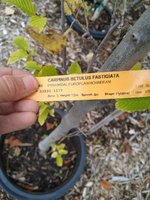I have no direct experience with the cultivars of Quercus you have listed. To the best of my knowledge, all oak cultivars are propagated by grafting. I do not believe a tissue culture protocol has been worked out yet specific to oak cultivars. I could be uninformed, but that is my current belief. Some of the trees you imaged from the nursery had clearly visible graft unions. Some I could not identify the graft union. Those specific trees would be better choices for bonsai.
However when, "chopping down" a grafted tree, it is important that you do not cut below the graft union. AND, that if buds emerge from below the graft union you do not allow those low buds to develop as they will be the understock species, and may have none of the desirable traits of the scion on the upper part. So your plan is good as long as you recognize that your tree will most likely be grafted. Take time and identify the graft union before trunk chopping. Be forewarned, for landscape industry, the graft union might be near the top of the tree rather than way down near the roots. Some landscape trees are triple grafts. A scion for the length of trunk is grafted on rootstock, then at the desired height, perhaps 4 or 5 feet above the root-trunkstock graft,, the trunkstock is grafted with the variety desired to be the foliage of the tree. Chopping below the upper graft will give you the trunk stock species, and chopping below the lowest graft will give you the root stock species. I doubt this effort is done for oaks, but it is fairly common for fruit trees such as apples, peaches and other stone fruit.
Do plan on your named oak cultivars to be grafted. So do not chop below the graft union.

























